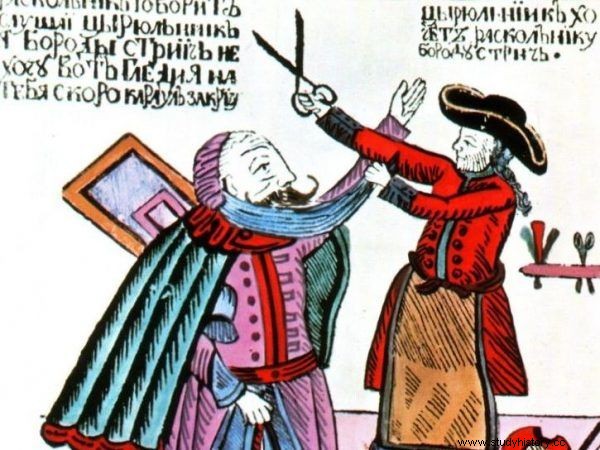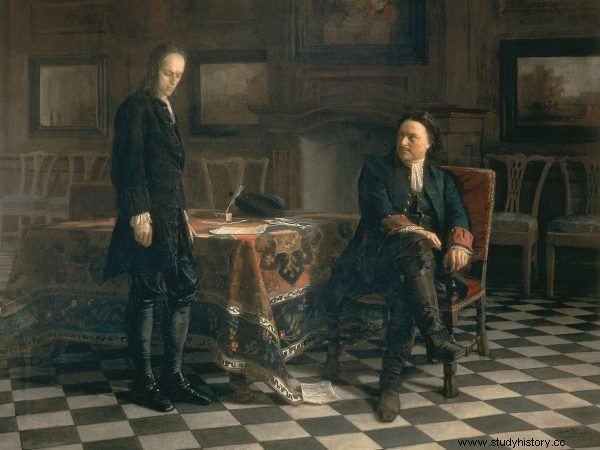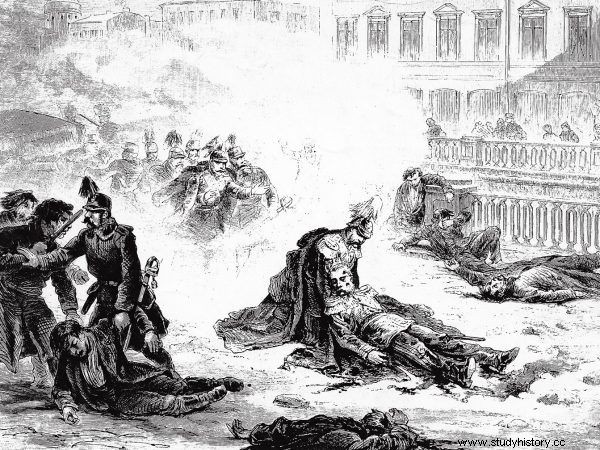They have abused children and the court, but have also experienced countless atrocities themselves. They contributed to the fall of Poland, but one of them proudly indicated that he had a Polish father. They professed Orthodoxy, but saved the ultra-Catholic order. What else should you know about the legendary Russian dynasty?
As always, all positions in the TOP10 ranking are based on the articles we publish. This time we decided to show the fascinating fate of the Romanov dynasty.
You didn't even suspect that…
10. The Romanov dynasty was close to extinction… even before it took the throne

Fyodor Romanov paid for the hunt for members of his family with a haircut on a monk. Many of his relatives were even less fortunate…
The handsome and elegant Fyodor Romanov (1553-1633) was a cousin of the last tsar of the Rurik family, Fyodor I. There were rumors that he was the one who was enthroned by the namesake of Monomakh, a symbol of power of the great Moscow dukes and tsars of Russia. Ultimately, however, the road to the reign of the Romanovs turned out to be much longer and more bumpy. Power was taken over by Boris Godunov, who turned against them, trying to eliminate the entire dynasty from the game . And he almost succeeded. Fyodor was imprisoned in a monastery, and his relatives were sent to different parts of the country, where they were kept under close supervision.
9. Catherine II saved the Jesuit Order

Oppressor of the Polish nation and protector of the Jesuits in one. Can be? It is possible!
On July 21, 1773, there was a formal dissolution of the Jesuit Order in the entire Catholic Church. The Order ceased to exist everywhere except… Russia. Catherine II, through the support given to the monks, wanted to hurt the Pope, who was against the partitions. Therefore, it prohibited the dissolution of the Polish territory taken over a year earlier. Regardless of this, the tsarina also hoped that the Jesuits would suppress subversive moods among Poles. Therefore, she kept them on a short leash, gradually making the existence of the order dependent on the state.
8. One of the Romanovs considered himself a Pole ...

Even the Russian Tsar Paul I wanted to be Polish.
Tsar Paul I was officially the son of Peter III and Catherine II. However, he believed that his biological father was ... Stanisław Poniatowski. He did not even mind that he was born a year before the first meeting of a Polish nobleman with Catherine II !! Probably Poniatowski seemed to him the most suitable candidate among his mother's many lovers. Although the former king of Poland tried to correct the tsar from his mistake, Paweł provided his "father" with a high standard of living and a decent funeral (read more on this topic).
7. ... and another treated the Polish mistress like his wife

Polish favorite of Tsar Alexander I in the painting by Josef Maria Grassi.
Tsar Alexander I in 1803 began an affair with Princess Maria Naryshkin, the daughter of Antoni Czetwertyński, a Pole from Targowicz. Their relationship lasted more than a decade and a half. The Tsar surrounded her with splendor, which she gladly used. The couple officially appeared as spouses. They appeared in this capacity, for example, at the Congress of Vienna (read more about this).
6. The Virgin Elizabeth was not that holy at all

Future Tsarina Elizabeth I hunting with her 6 years younger nephew, Tsar Peter II. Their relationship was spiced with a hint of incest. A painting by Valentina Serow from 1900.
Tsarina Elizabeth I was an old maid. But it had little to do with virginity. Even as a teenager she corrupted her nephew, Tsar Peter II . Soon after, she got into an affair with Simon Naryshkin. She even got married with another lover, Aleks Razumowski. Which, of course, was not enough reason for the "virgin" Elizabeth not to invite other gentlemen to her bed (read more on this).
5. One of the tsars used the services of "green men"

Tsar of Russia, Alexander III. Although he was privately a cousin of the Prince of Bulgaria, Alexander Battenberg, he did not hesitate to send "green men" on him.
Thanks to Russian protection, Alexander Battenberg, the cousin of Tsar Alexander III, became the first prince of Bulgaria. The Russians considered him their puppet. Unfortunately, they miscalculated, and Alexander began to become dangerously independent of the eastern Big Brother. To prevent this, the Russians created a fifth column in Bulgaria, based on the tsarist supporters who stayed in Bulgaria. It was the nineteenth-century version of "green men". In the summer of 1886, they even kidnapped the ruler (read more on that).
4. Peter the Great loved playing the "sadist dentist" ...

Peter the Great liked to play not only a barber, but also a dentist and a surgeon. At the sight of the tsar with a sharp instrument in his hand, the boyars could only pray that he would not start experimenting on them ...
Peter the Great defeated other rulers of Russia in medical "achievements". Already in his youth he was fascinated by tooth extraction . So he decided to do it himself! Medical experiments usually ended tragically for the victims of the Tsar. Piotr did not care because he treated patients as exhibits. Or toys.
3. … And he had his own son on his conscience

Alexei Tsarevich could not count on paternal pity or grace.
The same ruler became famous for his particular cruelty towards his own son. Peter was not pleased that his firstborn, Alexios, had not fallen into him. He even threatened to hand over the throne to a foreigner, so as not to leave him to a disappointing descendant. When it turned out that his son was plotting against him, the tsar called a court composed of the clergy, generals and senators. Tsarevich was sentenced to death. He died the day after his sentence, supposedly in the presence of his father (read more about this).
2. Alexander II survived as many as six attempts on his life

A graphic by Gustav Broling showing the seventh - successful - assassination attempt on Alexander II.
In 1867, Tsar Alexander II went to Paris for the opening of the World Exhibition. In the French capital, a Gypsy woman told him about seven attempts on his life. Indeed, many attempts were made to kill the ruler. The first attempt took place a year earlier. The bullet passed the target as the person standing next to the bomber knocked his hand away. But only the seventh assassin was successful (read more on that).
1. The Bolsheviks also brutally treated the other relatives of Nicholas II

Ipatiev's basement was not the only place where the Romanovs were executed in July 1918.
A day after they had dealt with the tsarist family, the Bolsheviks dealt with the Romanovs imprisoned in the school in Alapayevsk. There were Elizabeth, widow of Nicholas II's uncle, and five other relatives of the tsar. At night, they were driven to the flooded mine and pushed to a 20-meter shaft. Some have survived the fall. Attempts were made to finish them off with hand grenades and burning branches (read more on this).
